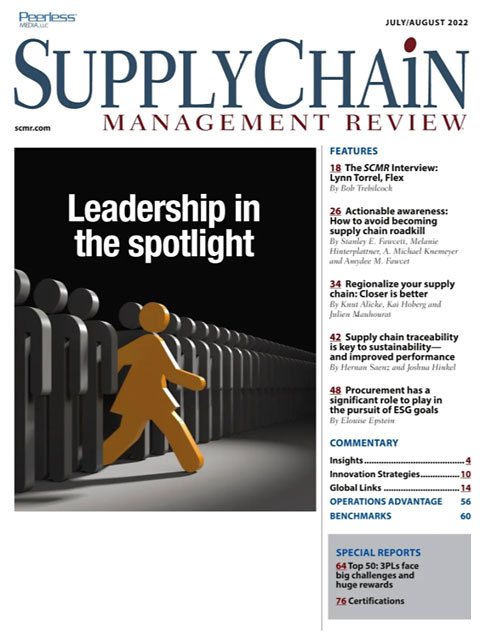Sorry, but your login has failed. Please recheck your login information and resubmit. If your subscription has expired, renew here.
July-August 2022
In late May, I attended the Institute for Supply Management’s first live conference since 2019. The message from Tom Derry, ISM’s CEO, was simple: These are challenging times, but along with the challenges come opportunities for those of us who can step up and lead our organizations into the future. One area where supply chain will be tasked with stepping up to the plate is going to be ESG, the initialism for environmental, social and governance. It was a major theme of the conference, and while all of the reporting requirements are still being debated, there’s little question that supply chain will lead the charge in environmental initiatives… Browse this issue archive.Need Help? Contact customer service 847-559-7581 More options
Over the last two years, the term supply chain management has gone from one primarily recognized by those within certain jobs to one frequently appearing in news stories. Supply chain disruptions are still regularly discussed by media outlets, and they continue to affect the lives of many: We refer to these as “average Joes,” or every day citizens who are outside of the profession but are affected by disruptions whenever they go to the store; and supply chain pros, or those individuals who work inside the supply chain profession to keep the wheels turning.
Earlier this year, APQC conducted a quick poll of individuals both inside and outside of the supply chain profession to determine the extent to which supply chain disruptions have affected their lives. The poll also sought to identify the degree to which these impacts affected different age groups. The poll had 320 global participants ranging from age 18 to over 55 years old.
APQC Infographic: Supply chain knowledge and concern for the future
The poll’s results show that nearly all of the respondents have experienced some level of disruption related to supply chains, and that about three-quarters of respondents were affected by higher prices related to supply chain issues. However, the degree to which respondents have been affected, and their opinion of the future of supply chains, varies by age group as well as whether they are average Joes or supply chain pros.
Getting Familiar
As part of the quick poll, APQC aimed to determine how much the news about supply chains has made a difference in the familiarity of average Joes, defined as those who are not employed in roles related to supply chains, with the concept of the supply chain. Unsurprisingly, the number of individuals who lack familiarity with supply chains has dropped over the last five years.
As shown in Figure 1, the trend is across all age groups. The largest drop occurs among the youngest respondents (age 18 to age 34), with a 21% decrease over the last five years. Close behind are respondents age 35 to age 44, with a 15% decline over five years.
It makes sense that the largest drop is among the youngest respondents, because during this period of their lives they may have become more aware of how the products they consume are manufactured and transported to retailers. For this and the other age groups, the fact that supply chain disruptions spanned multiple industries, coupled with the coverage of these disruptions in the media, has led to an overall greater awareness of the supply chain.
Figure 1: Lack of familiarity with supply chainsby “average Joes” over time
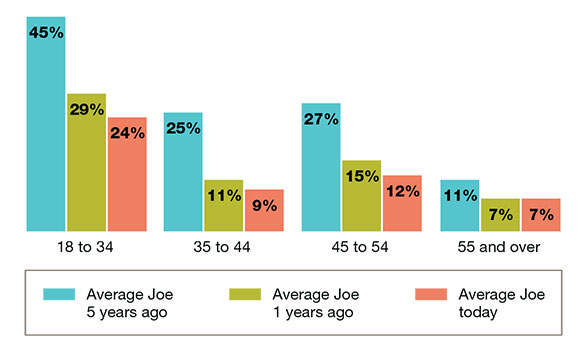
Source: APQC
In-depth supply chain knowledge
In a related result from APQC’s quick poll, a greater percentage of average Joes have in-depth knowledge of supply chains now versus five years ago. This is true across nearly all age groups. As shown in Figure 2, the largest increase was among respondents in the age 18 to age34 group, followed by the age 35 to age 44 group. The only group that did not have an increase was the group age 55 and older, which remained fairly consistent over five years.
In the age 18 to age 34 group, the percentage of individuals with in-depth knowledge of supply chains increased 13% over the last five years. In the group of individuals aged 35 to 44, the amount increased by 18%.
These results are in line with the types of disruptions experienced across age groups. Respondents in the average Joes category indicated that they mostly experienced multiple ongoing disruptions or some minor disruptions in their lives that they believe are tied to the supply chain. Individuals in these age groups have experienced enough disruptions that they have paid more attention to how the supply chain can affect their daily lives.
Figure 2: In-depth knowledge of supply chainsby “average Joes” over time
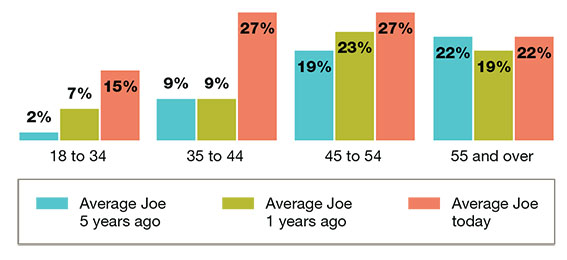
Source: APQC
It is worth noting that this poll question asked respondents to self-rate their knowledge of supply chains. Given that responses were from individuals outside the supply chain field evaluating their own knowledge of a topic outside of their normal expertise, we can expect for there to be a gap between respondents’ perception and their actual knowledge. We see this when evaluating poll respondents’ opinions about the future of supply chains.
Views on the future
Across all age groups, individuals not holding supply chain roles have become more aware of the supply chain during the pandemic. APQC considered whether increased awareness among this group affected its attitude about the future of supply chains.
The results are mixed. As shown in Figure 3, average Joes have a wide range of concern regarding the future of supply chain. In particular, the age 45 to age 54 group has a relatively large group of respondents that are not at all concerned about the future, although the largest group is moderately concerned.
Among individuals holding a job related to supply chain (dubbed supply chain pros for the purposes of this analysis), there is a higher level of concern overall. As shown in Figure 4, the largest groups, regardless of age, are in the moderately concerned or extremely concerned category. In fact, the only age group to have responses indicating no concern is the group age 55 and over. Every other age group has at least some level of concern.
Figure 3:“Average Joes” and concern with future of global supply chains
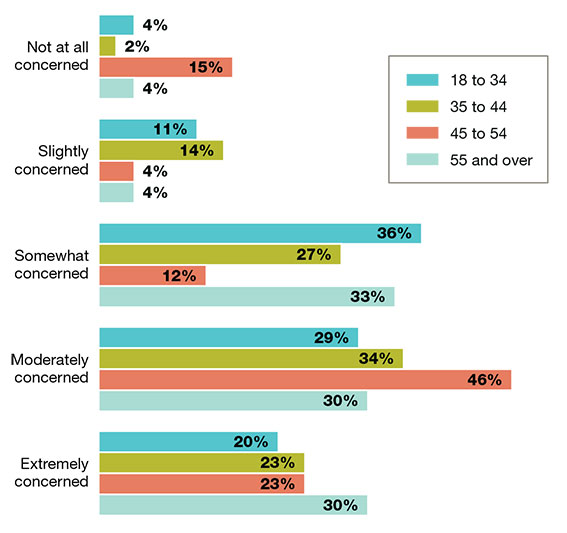
Source: APQC
These results show stark differences in the groups’ perception of the direction of supply chains. In the age 18 to age 34 group, there is a difference of 10% between the supply chain pros and the average Joes who are extremely concerned. The difference is even larger among those respondents age 55 and over: 15% more of the supply chain pros are extremely concerned compared with the average Joes.
Given their behind-the-scenes knowledge of supply chains, the pros are much more concerned about how well supply chains will bounce back from the disruptions of the pandemic. Many leaders of organizations fall into the 55 and over age group, making them uniquely positioned to understand the challenges supply chains still face. Average Joes, on the other hand, are not aware of factors that will affect global supply chains into the future, regardless of whatever knowledge they have gained during the pandemic.
Figure 4: Supply chain pros’ concernwith future of global supply chains
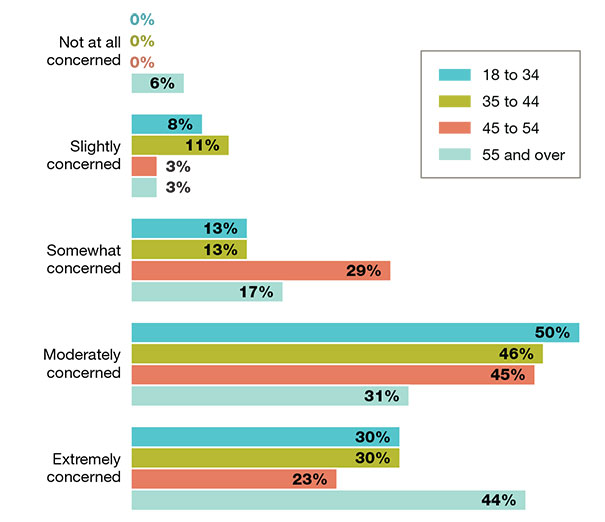
Source: APQC
Transparency is key
The heighted news coverage of the supply chain and its impact on all types of consumer goods have made average Joes more aware of what supply chains are and how they operate. These individuals have most likely been touched by supply chain disruptions—although the degree to which they have been affected varies widely.
The pros in the supply chain field have insight into the causes and long-term effects of disruptions. This makes them more likely to be greatly concerned about the future of global supply chains. However, as disruptions continue to affect a variety of products and industries connected to the daily lives of average Joes, this group has become more concerned about supply chain resiliency into the future.
In addition to the steps they are taking to shore up the resilience of their supply chains and recruit workers to fill in gaps, organizations should consider how to remain transparent with their partners and with consumers. Keeping partners aware of challenges allows them to address disruptions before they make further impacts down the supply chain. Providing honest updates on supply chain challenges can also build trust with consumers so that they remain loyal after disruptions have subsided.
About APQC
APQC helps organizations work smarter, faster and with greater confidence. It is the world’s foremost authority in benchmarking, best practices, process and performance improvement, and knowledge management. APQC’s unique structure as a member-based nonprofit makes it a differentiator in the marketplace. APQC partners with more than 500 member organizations worldwide in all industries. With more than 40 years of experience, APQC remains the world’s leader in transforming organizations. Visit us at apqc.org and learn how you can make best practices your practices.
SC
MR
Sorry, but your login has failed. Please recheck your login information and resubmit. If your subscription has expired, renew here.
July-August 2022
In late May, I attended the Institute for Supply Management’s first live conference since 2019. The message from Tom Derry, ISM’s CEO, was simple: These are challenging times, but along with the challenges come… Browse this issue archive. Access your online digital edition. Download a PDF file of the July-August 2022 issue.Over the last two years, the term supply chain management has gone from one primarily recognized by those within certain jobs to one frequently appearing in news stories. Supply chain disruptions are still regularly discussed by media outlets, and they continue to affect the lives of many: We refer to these as “average Joes,” or every day citizens who are outside of the profession but are affected by disruptions whenever they go to the store; and supply chain pros, or those individuals who work inside the supply chain profession to keep the wheels turning.
Earlier this year, APQC conducted a quick poll of individuals both inside and outside of the supply chain profession to determine the extent to which supply chain disruptions have affected their lives. The poll also sought to identify the degree to which these impacts affected different age groups. The poll had 320 global participants ranging from age 18 to over 55 years old.
APQC Infographic: Supply chain knowledge and concern for the future
The poll’s results show that nearly all of the respondents have experienced some level of disruption related to supply chains, and that about three-quarters of respondents were affected by higher prices related to supply chain issues. However, the degree to which respondents have been affected, and their opinion of the future of supply chains, varies by age group as well as whether they are average Joes or supply chain pros.
Getting Familiar
As part of the quick poll, APQC aimed to determine how much the news about supply chains has made a difference in the familiarity of average Joes, defined as those who are not employed in roles related to supply chains, with the concept of the supply chain. Unsurprisingly, the number of individuals who lack familiarity with supply chains has dropped over the last five years.
As shown in Figure 1, the trend is across all age groups. The largest drop occurs among the youngest respondents (age 18 to age 34), with a 21% decrease over the last five years. Close behind are respondents age 35 to age 44, with a 15% decline over five years.
It makes sense that the largest drop is among the youngest respondents, because during this period of their lives they may have become more aware of how the products they consume are manufactured and transported to retailers. For this and the other age groups, the fact that supply chain disruptions spanned multiple industries, coupled with the coverage of these disruptions in the media, has led to an overall greater awareness of the supply chain.
Figure 1: Lack of familiarity with supply chainsby “average Joes” over time

Source: APQC
In-depth supply chain knowledge
In a related result from APQC’s quick poll, a greater percentage of average Joes have in-depth knowledge of supply chains now versus five years ago. This is true across nearly all age groups. As shown in Figure 2, the largest increase was among respondents in the age 18 to age34 group, followed by the age 35 to age 44 group. The only group that did not have an increase was the group age 55 and older, which remained fairly consistent over five years.
In the age 18 to age 34 group, the percentage of individuals with in-depth knowledge of supply chains increased 13% over the last five years. In the group of individuals aged 35 to 44, the amount increased by 18%.
These results are in line with the types of disruptions experienced across age groups. Respondents in the average Joes category indicated that they mostly experienced multiple ongoing disruptions or some minor disruptions in their lives that they believe are tied to the supply chain. Individuals in these age groups have experienced enough disruptions that they have paid more attention to how the supply chain can affect their daily lives.
Figure 2: In-depth knowledge of supply chainsby “average Joes” over time

Source: APQC
It is worth noting that this poll question asked respondents to self-rate their knowledge of supply chains. Given that responses were from individuals outside the supply chain field evaluating their own knowledge of a topic outside of their normal expertise, we can expect for there to be a gap between respondents’ perception and their actual knowledge. We see this when evaluating poll respondents’ opinions about the future of supply chains.
Views on the future
Across all age groups, individuals not holding supply chain roles have become more aware of the supply chain during the pandemic. APQC considered whether increased awareness among this group affected its attitude about the future of supply chains.
The results are mixed. As shown in Figure 3, average Joes have a wide range of concern regarding the future of supply chain. In particular, the age 45 to age 54 group has a relatively large group of respondents that are not at all concerned about the future, although the largest group is moderately concerned.
Among individuals holding a job related to supply chain (dubbed supply chain pros for the purposes of this analysis), there is a higher level of concern overall. As shown in Figure 4, the largest groups, regardless of age, are in the moderately concerned or extremely concerned category. In fact, the only age group to have responses indicating no concern is the group age 55 and over. Every other age group has at least some level of concern.
Figure 3:“Average Joes” and concern with future of global supply chains

Source: APQC
These results show stark differences in the groups’ perception of the direction of supply chains. In the age 18 to age 34 group, there is a difference of 10% between the supply chain pros and the average Joes who are extremely concerned. The difference is even larger among those respondents age 55 and over: 15% more of the supply chain pros are extremely concerned compared with the average Joes.
Given their behind-the-scenes knowledge of supply chains, the pros are much more concerned about how well supply chains will bounce back from the disruptions of the pandemic. Many leaders of organizations fall into the 55 and over age group, making them uniquely positioned to understand the challenges supply chains still face. Average Joes, on the other hand, are not aware of factors that will affect global supply chains into the future, regardless of whatever knowledge they have gained during the pandemic.
Figure 4: Supply chain pros’ concernwith future of global supply chains

Source: APQC
Transparency is key
The heighted news coverage of the supply chain and its impact on all types of consumer goods have made average Joes more aware of what supply chains are and how they operate. These individuals have most likely been touched by supply chain disruptions—although the degree to which they have been affected varies widely.
The pros in the supply chain field have insight into the causes and long-term effects of disruptions. This makes them more likely to be greatly concerned about the future of global supply chains. However, as disruptions continue to affect a variety of products and industries connected to the daily lives of average Joes, this group has become more concerned about supply chain resiliency into the future.
In addition to the steps they are taking to shore up the resilience of their supply chains and recruit workers to fill in gaps, organizations should consider how to remain transparent with their partners and with consumers. Keeping partners aware of challenges allows them to address disruptions before they make further impacts down the supply chain. Providing honest updates on supply chain challenges can also build trust with consumers so that they remain loyal after disruptions have subsided.
About APQC
APQC helps organizations work smarter, faster and with greater confidence. It is the world’s foremost authority in benchmarking, best practices, process and performance improvement, and knowledge management. APQC’s unique structure as a member-based nonprofit makes it a differentiator in the marketplace. APQC partners with more than 500 member organizations worldwide in all industries. With more than 40 years of experience, APQC remains the world’s leader in transforming organizations. Visit us at apqc.org and learn how you can make best practices your practices.
SC
MR


Latest Supply Chain News
- Few executives believe their supply chains can respond quickly to disruptions
- Technology’s role in mending supply chain fragility after recent disruptions
- Tech investments bring revenue increases, survey finds
- Survey reveals strategies for addressing supply chain, logistics labor shortages
- Israel, Ukraine aid package to increase pressure on aerospace and defense supply chains
- More News
Latest Podcast

 Explore
Explore
Business Management News
- Few executives believe their supply chains can respond quickly to disruptions
- Technology’s role in mending supply chain fragility after recent disruptions
- Survey reveals strategies for addressing supply chain, logistics labor shortages
- How CPG brands can deliver on supplier diversity promises
- How S&OP provides the answer to in-demand products
- AI, virtual reality is bringing experiential learning into the modern age
- More Business Management
Latest Business Management Resources

Subscribe

Supply Chain Management Review delivers the best industry content.

Editors’ Picks





